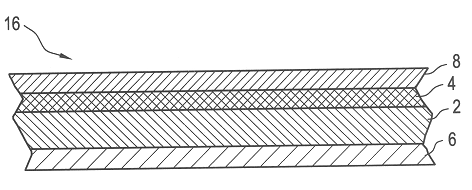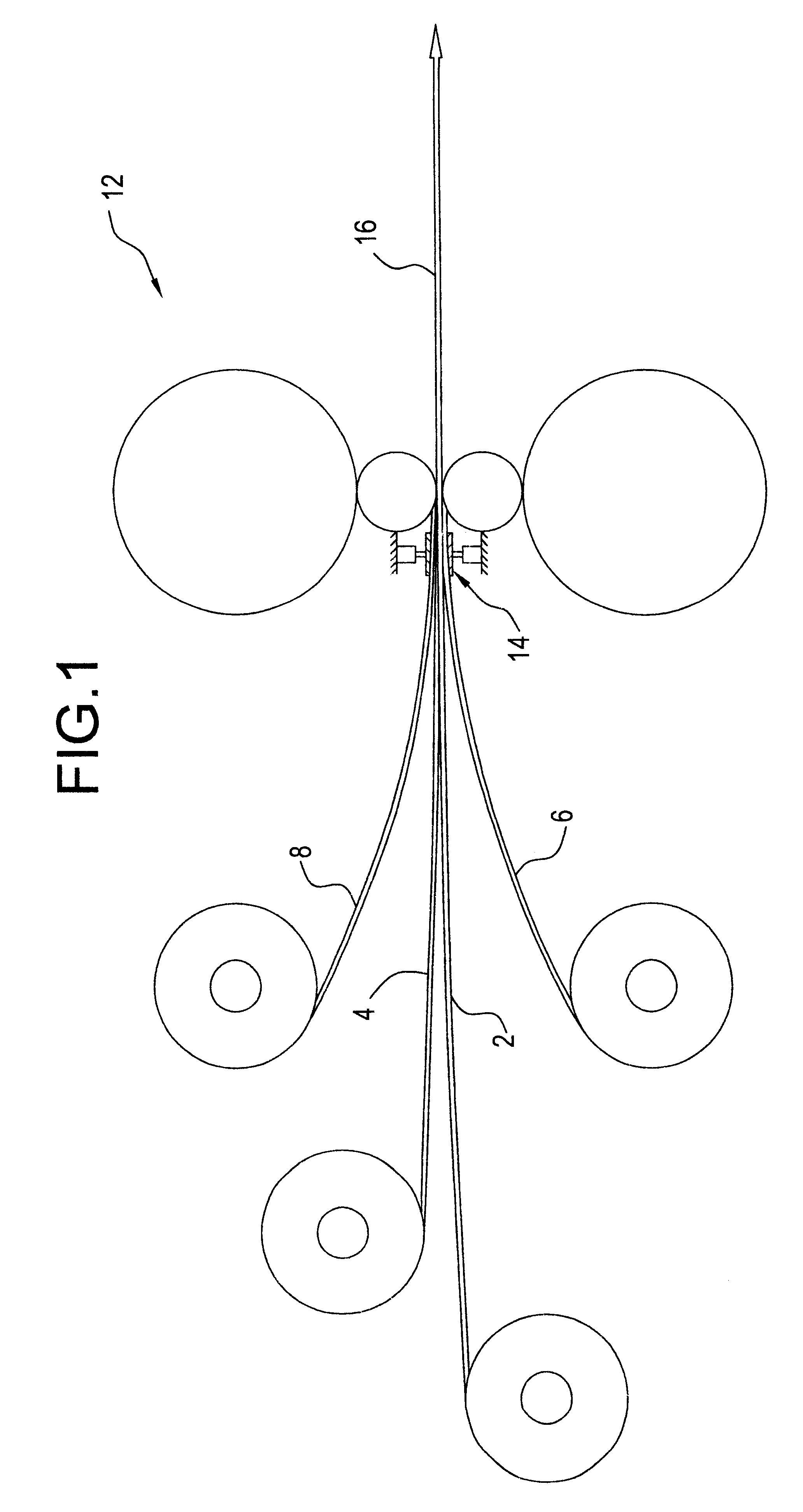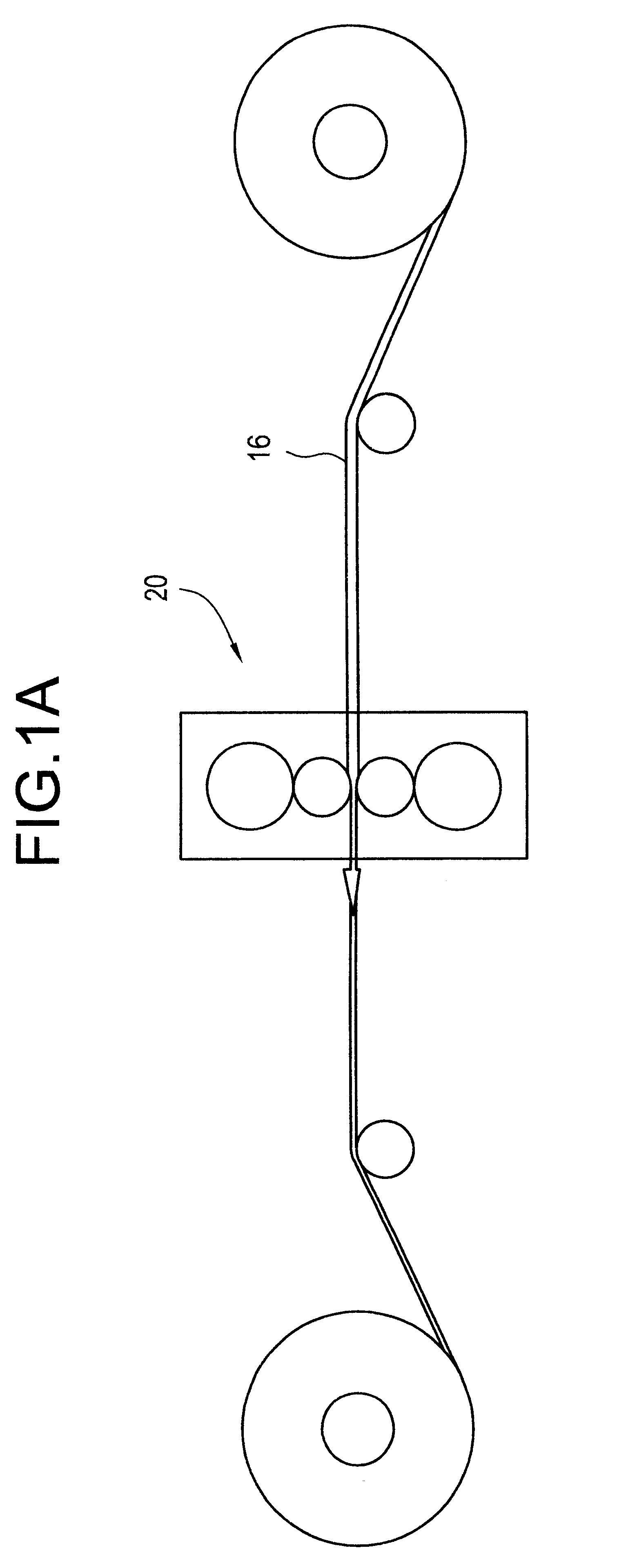Method of making clad materials using lead alloys and composite strips made by such method
a technology of lead alloys and composite strips, applied in the direction of cell components, soldering devices, manufacturing tools, etc., can solve the problems of limiting the range and the usefulness of electric and hybrid vehicles, such batteries, and their bulky size and heavy weight, and achieve the difficulty of manufacturing composite plates and grids
- Summary
- Abstract
- Description
- Claims
- Application Information
AI Technical Summary
Benefits of technology
Problems solved by technology
Method used
Image
Examples
example i
It A continuous strip 2a of fully annealed CP (commercially pure) titanium (Grade 50A) having a nominal thickness of 0.021 of an inch was thoroughly cleaned and scratch brushed. Two continuous strips 4a, 6a of fully age hardened lead alloy, each of nominal chemical composition of lead -0.06% calcium-1.5% tin, and each having a nominal thickness of 0.015 of an inch were cleaned by vapor degreasing. The cleaned and brushed CP titanium was sandwiched between top and bottom layers of lead alloy and then rolled on a conventional roll bonding mill having essentially dry bonding rolls in one pass with sufficient force to reduce the sandwich package thickness from about 0.051 of an inch to about 0.023 of an inch. i.e., a reduction of about 54% and using minimal tension on the separate layers. A sample of the; roll bonded composite material thus produced is shown in FIG. 10, a micro-photograph of a cross section of the roll bonded tri-clad composite comprising lead alloy 4a / CP titanium 2a / le...
example ii
The same process as described in Example I except that the core layer 2b was fully annealed SAE 304 stainless steel having a thickness of 0.036 of an inch. In the roll bonding operation the initial'sandwich thickness of about 0.066 of an inch was reduced to a roll bonded thickness of about 0.030 of an inch, i.e., about 55% reduction. FIG. 12 shows a cross sectional micro-photograph of the tri-clad lead alloy 4a / 304ss 2b / lead alloy 6a showing the establishment of a continuous solid state bond at the lead and the stainless steel interfaces.
example iii
This example was carried out in the same manner as in Example I except that the core layer used was fully annealed SAE 1008 low carbon steel (LCS) having a thickness of 0.038 of an inch. In the roll bonding operation the initial sandwich thickness of about 0.068 of an inch was reduced to a bonded thickness of about 0.028 of an inch, i.e., about 59% reduction. FIG. 13 shows a cross sectional micro-photograph of the tri-clad lead alloy 4a / 1008LCS 2c / lead alloy 6a showing the establishment of a continuous solid state bond at the lead and the 1008LCS interfaces.
PUM
| Property | Measurement | Unit |
|---|---|---|
| speed | aaaaa | aaaaa |
| rolling speed | aaaaa | aaaaa |
| thickness | aaaaa | aaaaa |
Abstract
Description
Claims
Application Information
 Login to View More
Login to View More - R&D
- Intellectual Property
- Life Sciences
- Materials
- Tech Scout
- Unparalleled Data Quality
- Higher Quality Content
- 60% Fewer Hallucinations
Browse by: Latest US Patents, China's latest patents, Technical Efficacy Thesaurus, Application Domain, Technology Topic, Popular Technical Reports.
© 2025 PatSnap. All rights reserved.Legal|Privacy policy|Modern Slavery Act Transparency Statement|Sitemap|About US| Contact US: help@patsnap.com



